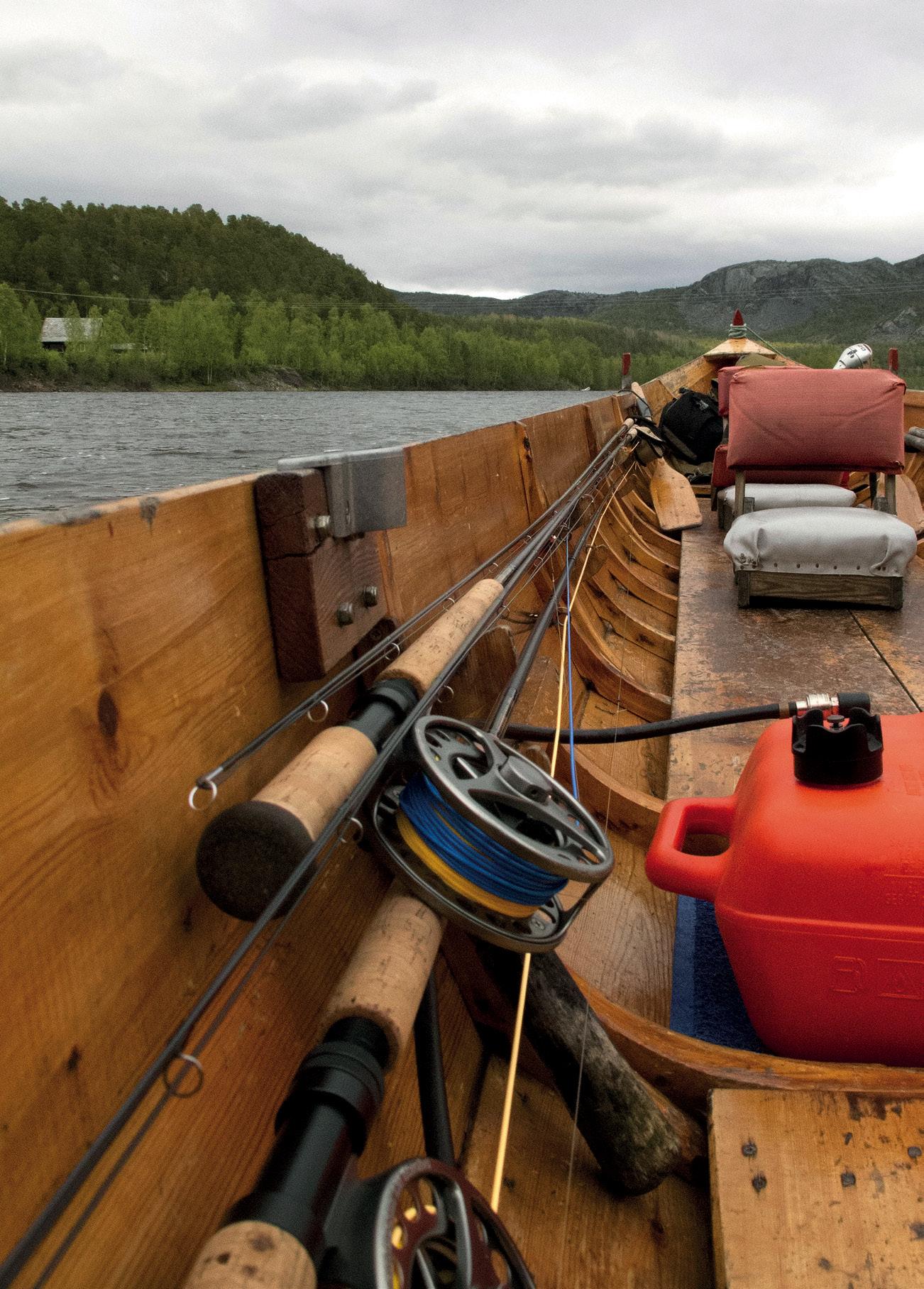

Salmon Fishing From a Different Angle
The water is fast, but the boat effortlessly stays in place. Trond, the boatman, rows from the top of the boat; Timo, my fishing partner, stays at the bottom, waiting his turn. I fish from the back of the boat. With this level of water, it´s more or less impossible to fish this pool from the bank.
ANOTHER BOAT IS on the next pool with the other team; Antti, Hilmar and the boatman Sverre. It´s the middle of June and we are fishing the Mighty Alta.

Fly fishing for Atlantic salmon from a boat is a common way to fish the Alta in Norway, the River Tay in Scotland, and some rivers in Canada and the Kola Peninsula in Russia. Later in this article we focus
on salmon fishing on the Tana River. They each have one thing in common: these are all big rivers. It can be easy or challenging to cast from the boat, depending on how well you can adapt to it. The reward is that if you are reasonably adept, you can fully cover every pool. You must be quite a good caster, because you have a boatman and fishing partner on the boat with you. It is not always possible to cast from your better side. Casting from both sides is an important skill,
Text and photos: Miki Äikäseven if fishing from the bank. And of course, it is always useful to know a number of casting styles.
When fishing from the boat, getting the correct position on the pool is much easier compared to fishing from the bank, especially on big rivers. Also, moving from pool to pool is very easy with the boat. We all know that positioning is the key thing to successful salmon fishing. When we find the right spot, we can fish the correct length of line; just sufficient to get a good “pull” on the line from the river. On some pools a sinking line presents a fly better than a floater
(even in low water), and on some pools it is the other way round.
On Alta, the boats are 8 meters long or more, and very steady. They are made for traveling along the river and for casting from the boat. These guys, the boatmen, are top guides who know pools of the river intimately.
Our Alta guides, Sverre and Trond, have worked on this river all their life. Their passion for fly fishing and their skills on the boat make them most wanted guides on the Alta. These guys make most of their living during the fishing season, so tools, engines and boats are kept in
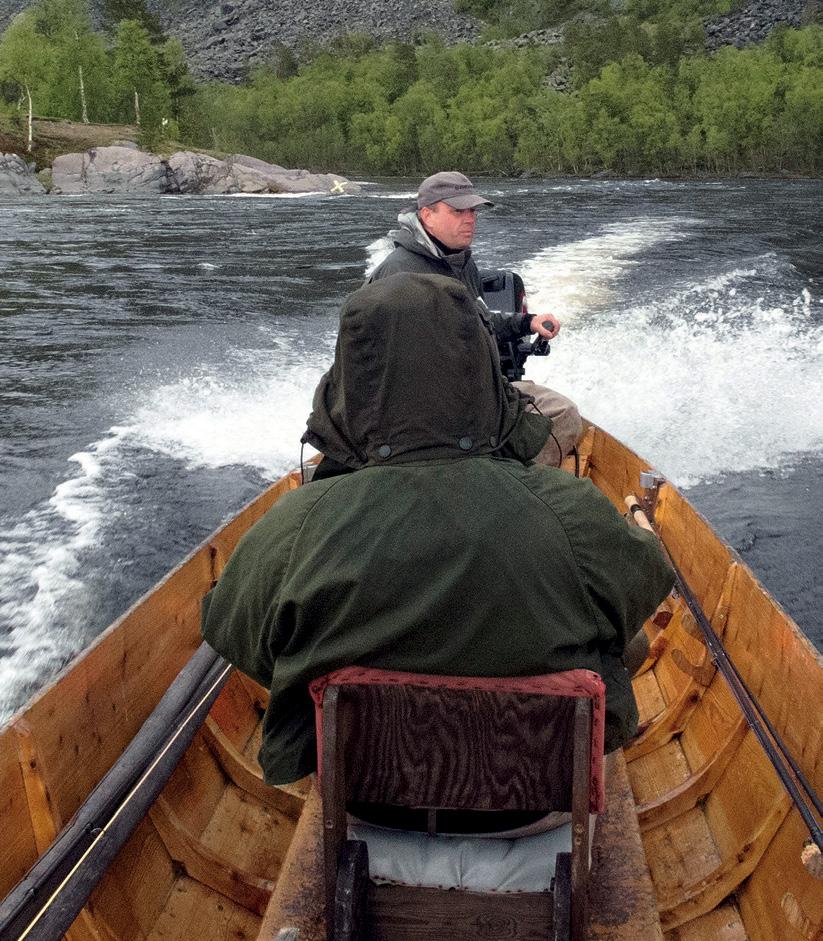
top shape. These Norwegian- style riverboats are totally different in comparison to the boats on the Tay, in Scotland. The Norwegian boats are long and slim; on the Tay boats are short and wide. On Alta and Tana, boats are used for travelling throughout the river, whereas on the Tay almost every beat has its own boats.
Another large river, where the use of boats is widespread, is the River Tana, which flows between Norway and Finland. I was fishing there many years ago, at the beginning of June. There was very high water, and
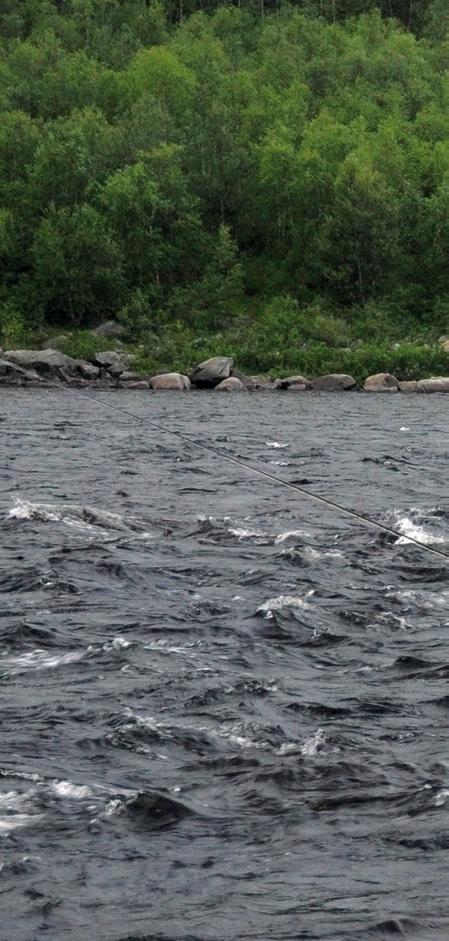
fishing from the bank was terrifying on this huge river. I was very lucky to meet an old friend of mine, Matti Rytinki. Matti’s home was a small village by the Tana called Nuorgam; he made his living on Tana, rowing customers and fishing with a variety of spoons and flies. This is the best way to fish Tana. Anyway, I was standing by the river when Matti came to me and asked if I´d like to get a ride to the Norwegian side of the river. He said that he had a customer coming, but had time to carry me over and pick me up again after his session with the customer. I was very pleased
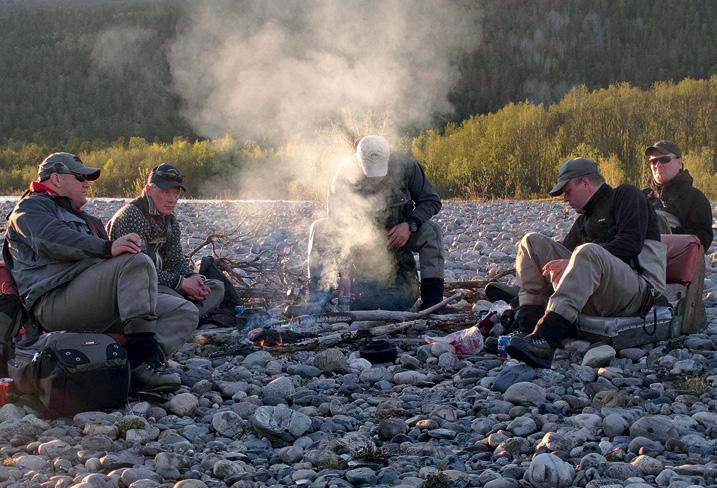
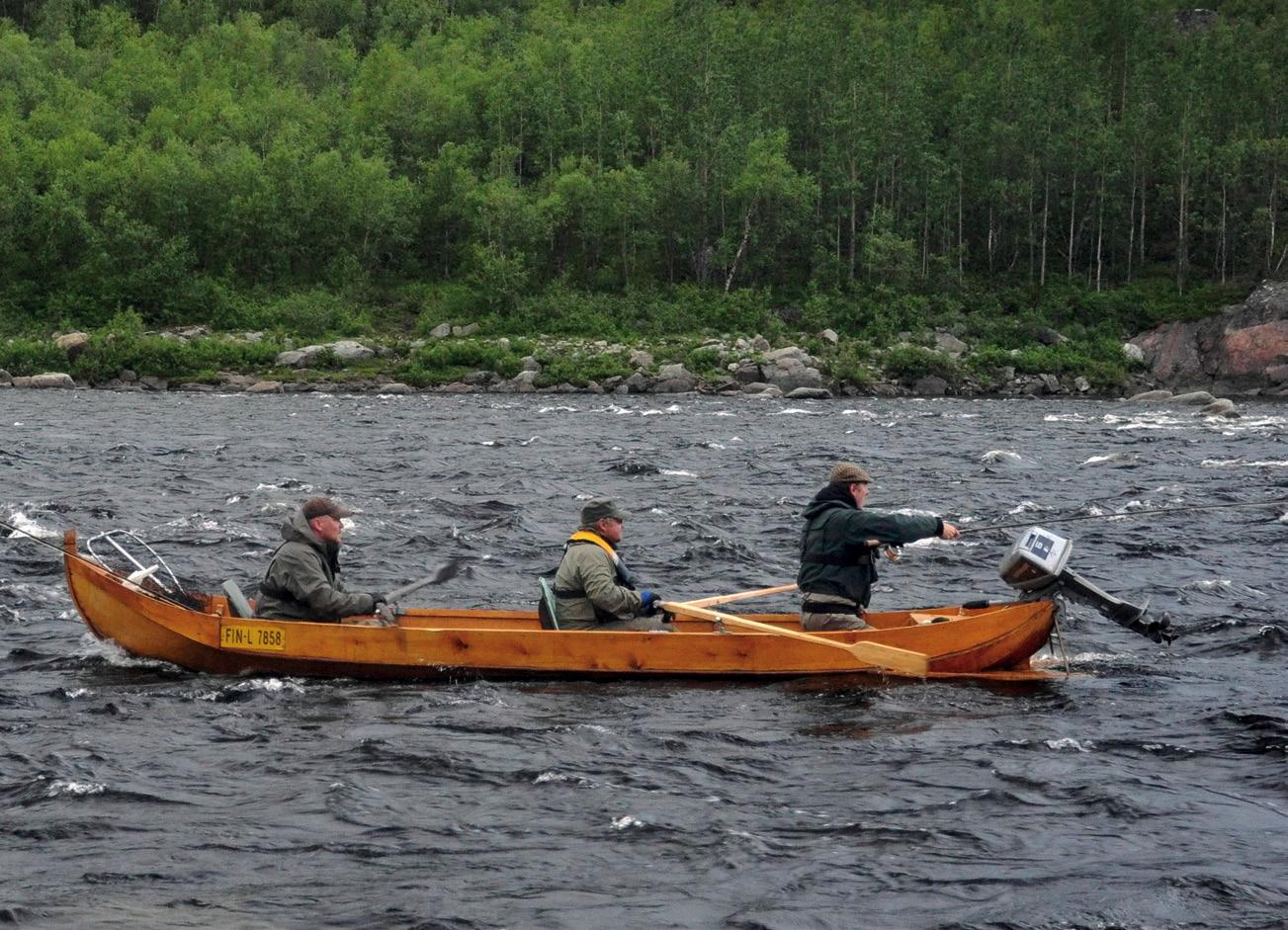
about that, and after a few hours I was rewarded with a good sized salmon. At the same time, Matti and his customer in the boat reached all the best pools and spots on the river, catching salmon with an ease that I could only dream of from the bank. This was the first time I properly considered fly fishing from the boat on Tana. There is no culture of casting from the boat here; the lures are worked by the boatman. Many years and several failed plans later, Matti and I finally managed to find the time to try fly fishing from the boat.
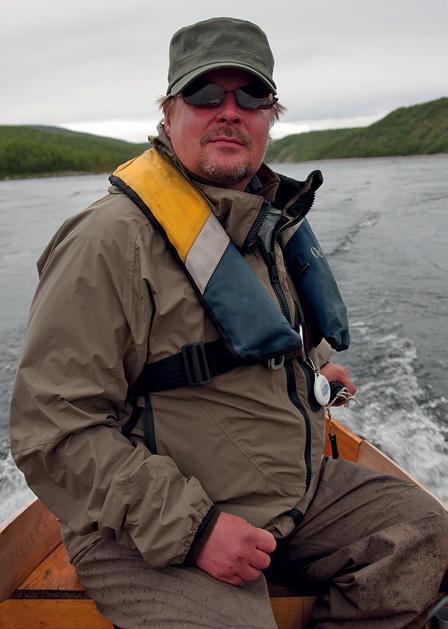
It was the end of July, a perfect time for fly fishing from the boat. This time in the Tana valley is known as “Theetles Time” for salmon. At this time of the season the salmon is losing its teeth, and if there are no new fish coming in, it is hard to get those old big ones to take the fly. But we did know that and this trip was planned for testing and learning this type of fishing at the Tana. We have
a team of four of us: Matti as boss, my friends Antti and Timo, both very skilled fly casters and fishers, and me. We planned to fish a place called Piltamo, a few miles upstream from huge rapids called Storfossen. Only locals can row here. This area can be fished from the bank, but if you want to get good fishing all the way, you have to go to the middle of the river. It´s simply impossible to reach the best holding spots from the bank. It is reassuring that Matti knows every stone and hole in this area; every cast can be “The One”. The Piltamo is a place that holds lots
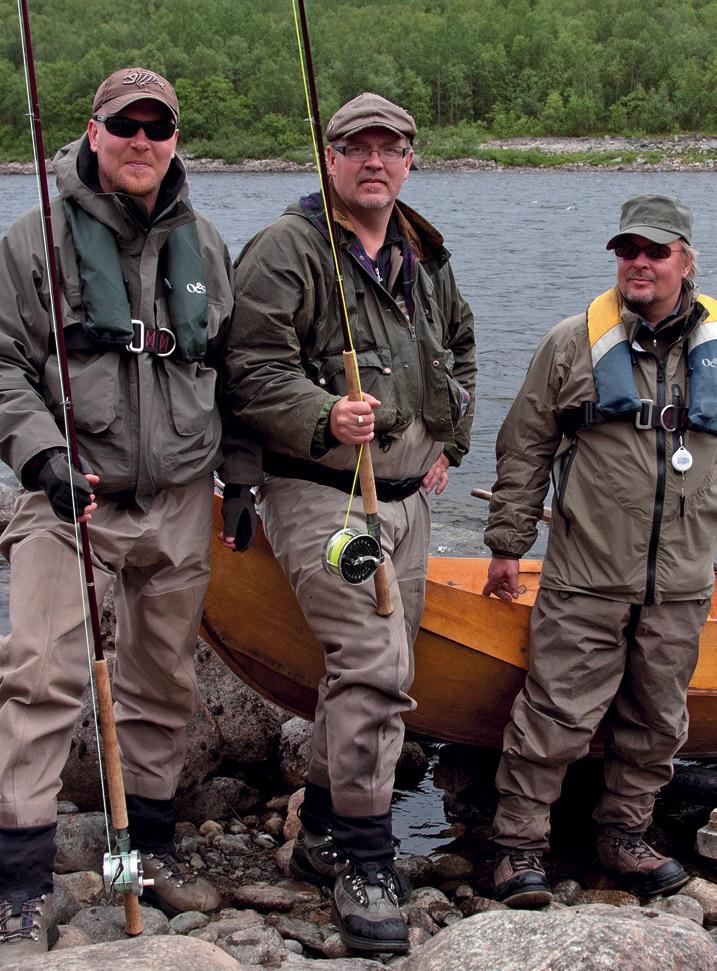
of resting fish which have just passed Storfossen. The salmon stay below the Storfossen during the day; when the night comes, they run through the rapids and rest at the Piltamo before continuing to the upper parts of the Tana.
There are pools at the Piltamo, which from the start of the season are home to some of Tana’s legendary monsters. It is good to appreciate the sheer size of the fish you can catch on the Tana. For example, at the Piltamo area is a hole called Valle´s Hole, named after Nils Valle, famous salmon fisher from the Tana valley.
Nills has managed to land salmon up to 36 kg; while his son, who still lives there, had a 32kg fish from the same place.
The boats at the Tana are different from those on the Alta. The basic measurements are quite similar, but Tana boats are more or less made for rowing. The length of these is around 5-6 meters. Matti built the new boat in spring for this kind of fishing; this one is a little wider and higher than normal, and very steady. When fishing a place like the Piltamo, the boat cannot be as long as on Alta,
because it has to be able to turn up and down on the heavier current. It was very exciting to watch and learn how Matti handles the boat in the stream. Matti said that the waves are not bad, but the rocks can be. We usually stand at the back of the boat, but there are places where we have a little more current and it was easier to stay on your knees on the floor. There was soft kneepad on the floor, so it was easy on our knees.
I was rigged with two 15 footers, one with an inter-2-4 sinking shootinghead, and the other with
Skagit- body with clear intermediate tip. Earlier I was talking with Matti about the gear. They use 8 meters of line when they row spoons and flies in this part of river. So Matti suggests I make a line that will be short and can be used easily for those little pockets around the rocks. A short bodied Skagit was the perfect choice, and it was easy to change the tips if needed. When fishing in Tana, it is important to pay close attention to your gear. Tana holds some of the largest Atlantic salmon on the earth, so playing with a candy stick is madness. Also, the leaders must be quite strong, around 0,40mm or more. The fish can be well over 20 kg and there are lots of rocks on the bottom. Of course somebody will think; “sure I can handle it with lighter tackle”, but the Tana is King of the Atlantic salmon rivers, and you really need to respect it. After your first fishing trip there, you will know what I am talking about. You will love it, or you will hate it; it is simple as that. And even if you hate it, you find yourself drawn back from time to time. They say at the Tana, “The river can reward you, but it will, for sure, humiliate you some day”.
Anyway, we were there at the Piltamo, and because there was a very strong upstream wind, Matti recommended that we start with two guys on the oars. Matti and Antti took the oars, and I was first to try fishing. I was a little scared when we got close to the neck of the Piltamo. The current is very soft and slow here, and it was really easy to cast from the boat. There are several groups of rocks and behind those are deeper places where fish are lying. Normally, in these kinds of places salmon take at the back of the deeper area, where
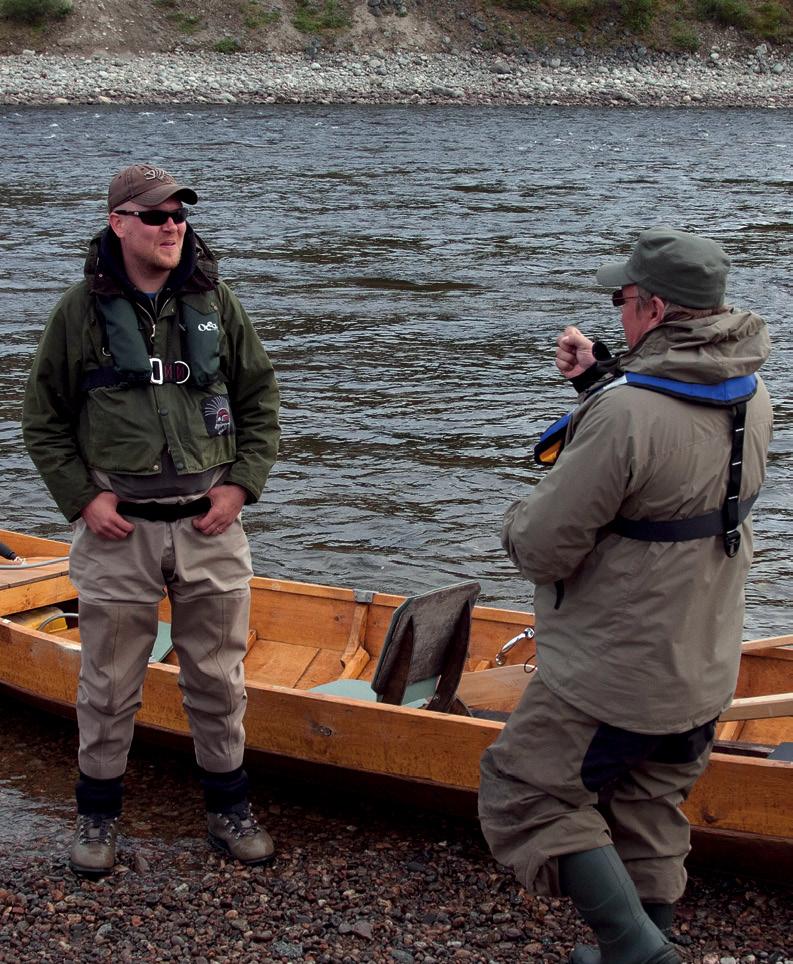
the pool shallows, so we drifted the boat behind the rocks and it stayed there easily. We made several casts and then moved to the next spot. After fishing a few of those deeper holes Matti suggested using a sinking line. I did have a little tube fly on a sinking line, and I cast it to one of the deeper holes. A fish took quite gently. We all were very excited; this was the first time anybody had fished the Piltamo like this. Matti told me to sit down, started the engine and, very gently, headed for the shore. The salmon followed obligingly; at that point I thought it was a grilse. When we hit the shore, the fish ran for the current and was off. The rush was strong and fast and it was clearly no grilse, maybe a medium sized Tana fish or bigger. But it was gone. Nobody worried about losing a fish; no way. We were excited; this will work here. We had decided when we planned this trip that it was to be about demonstrating the possibilities of this style of fishing in comparison to fishing from the shore. We fished through the pools all the way to the end of Piltamo, but no more fish.
Hours go by, and we got used to fishing like this. After a few rounds with two rowers, Matti said that it would be best if he rowed alone. It worked extremely well and we decided to continue like that. There were lots of places where we could find the fish, but we decided to focus on 4-5 pools, which could be fished with a slightly longer line. One round on the boat takes an hour or so.
The key thing for us all was learning from Matti. Matti fishes every day of the season; if not with customers, then by himself. The first major lesson was in fly size. I am a big
fly- guy and did not understand why Matti didn’t let me use the tube flies that I would normally use. He wanted to use smaller flies dressed on double hooks. His standard size was a 4 or a 6 and sometimes smaller. His argument is that if there are a lot of rowers who use spoons, and they don’t have a bite, why should we use the same size of fly? He believes that we have a better chance of hooking a fish if we offer a much smaller lure to the salmon. Well I have to say that Matti won this argument, and my tubes stayed in the box most of the time. Maybe it was better his way.
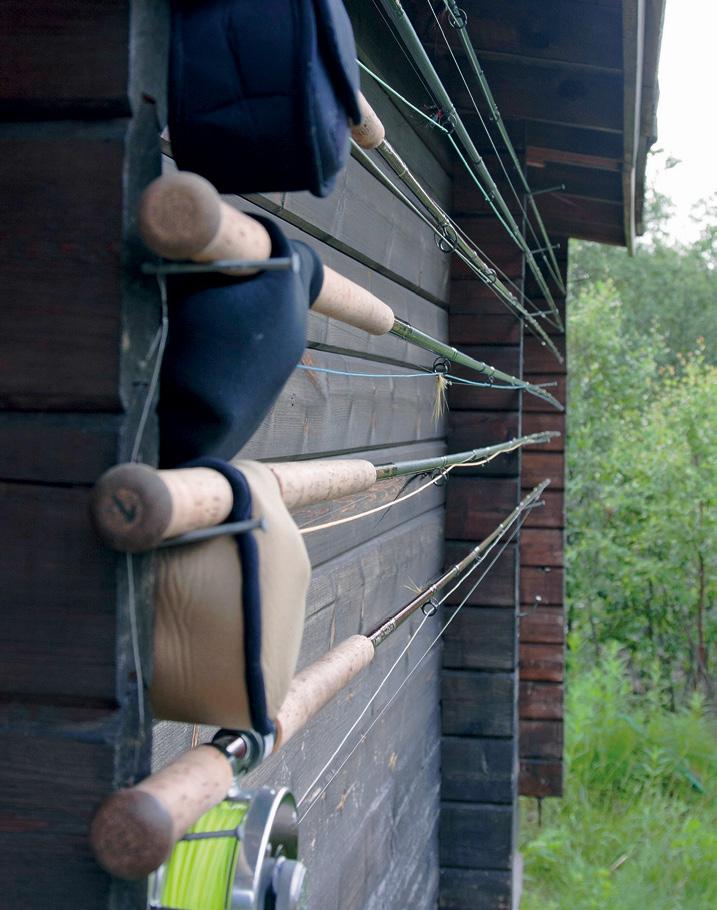
Another difference between boat fisher and fly caster is in the role of the boatman. Matti normally manoeuvres the boat to move the flies and spoons; now he had to position the boat to ensure a good angle for presenting our flies. I found that in the pools we fished it was enough to cast an 11m shooting head and 10 meter running line. I explained to Matti, that in my opinion a shooting head will “work” better, if you have a specific amount of running line pulled off the reel. What is a good length of running line?
It is determined by the
configuration and current of each pool, but it is mostly about the head you are using. For example, I like to use a sinking shooting head some times. My favourite sinking line is Guideline Triple D inter/2/4. It works best if I have 10 to 15 meters running line out. I do not use sinkers as a weight; rather I use them for controlling the speed of the line. As I said earlier, sometimes a sinker will present the fly better than a floater, and sometimes it is the other way. We all know that, but those guys who know how to choose the right line at the right time, get more fish than guys who use the same methods all the time.
We stayed at Timo’s charming little cabin on the Nuorgam. Matti has a very good tent by the Piltamo. It is large with a heater and beds. He hires his tent to customers, if they want to
stay by the river all the time.
Tana is a big river and its salmon can be huge. It runs for approximately 200km and is well known as a border between Norway and Finland. Accordingly, Tana stirs up lots of feelings between the two nationalities.
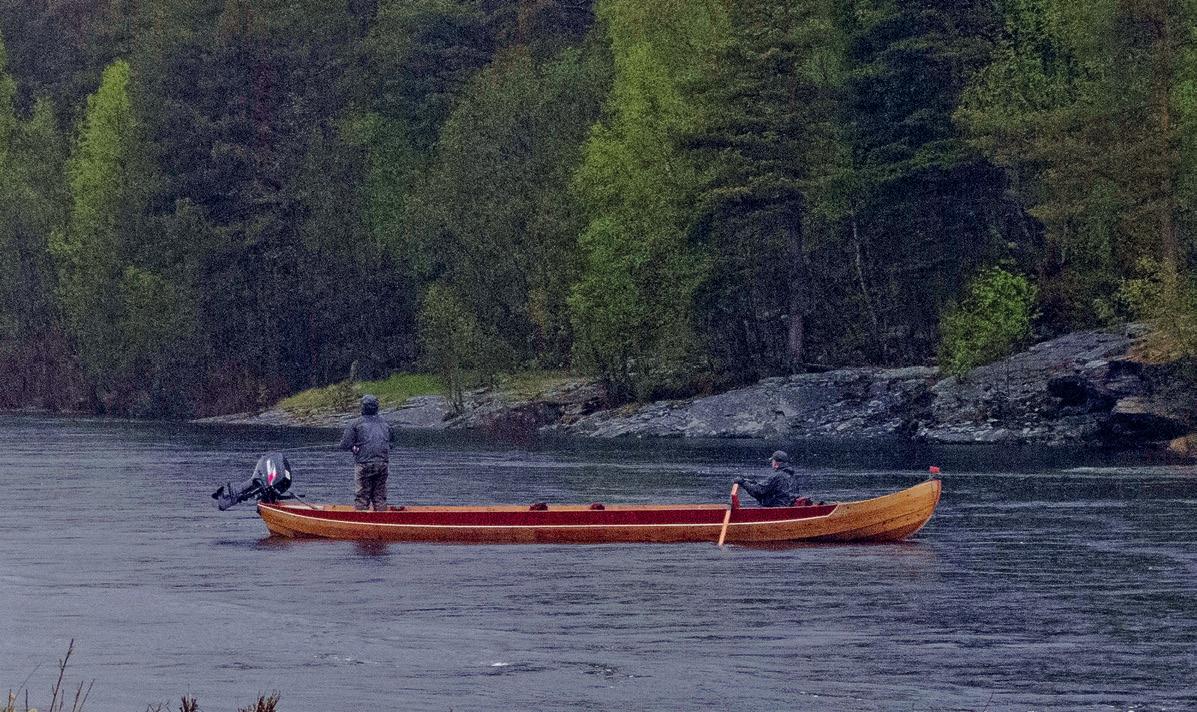
The Norwegians criticise the Finnish, and the Finnish criticise the Norwegians; together, they criticise the other nationalities, who find their way to Tana. As a fly fisher I cannot understand this; visiting anglers are very important to local economies. This river has huge potential for a fly fisher, particularly casting from the boat. With the correct rules for fishing, the introduction of bag limits and an end to netting at the sea, the Tana will once more become the best Atlantic salmon river on the globe. Overall, fishing from the boat can be very productive. These huge
rivers, like Tana, offer so much more to fly fisherman when fished from a boat. The boat can be positioned to enable the angler to reach the best taking spots. Travelling from pool to pool on a river-boat is also a great experience. There are lots of places along the river which can only be reached with the boat. And if you have a guide like Matti, who knows the river like his own pockets, your chances will be much better than from the bank. There is so much to learn from these guys who live there by the river.
I believe that casting a fly from the boat is here to stay. It is important to respect the traditional way of fishing the Tana and the expertise of its boatmen. One thing is for sure, I will be back to the Tana, casting from the boat. ■
